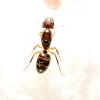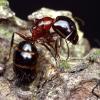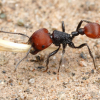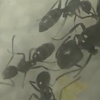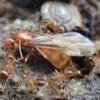Today's unseasonably warm high was 77 F so naturally P. imparis was out flying. It wasn't that big of a flight though but I did manage to catch a queen. I'm in souther NJ for those of you wondering, Camden County specifically. A friend of mine in Ocean County also caught a queen of this species today.
Out in California I'm happy to add that someone finally got decent pictures of the form of "this species" that has totally black queens. Prior to this the only evidence it existed was a video of a P. imparis flight where the more typical color form was flying but mixed in were black queens which were not in the best focus. Even looking at the image I've linked to above, my first thought was Lasius alienus or one of the other Lasius in the niger group we rarely hear about. The eyes on the head are completely wrong of course, so I messaged James Trager and asked him if I'm crazy. He identified it as a P. imparis queen, and rekindled my belief that they are multiple species.
There had been a study done which looked at the male genitalia in the species to see if there was anything different. The idea being if a square peg can't fit in a round hole then the flow of genetics can't be transferred and is one of many indicators that multiple species exist. This would explain why some P. imparis queens are noticeably larger and smaller than one another, and I've even come across a colony that had a queen which was totally blond in color. Workers to some nests seem are be small and pale, often nesting in sand, while others are larger and darker forming long foraging lines that reach up into the trees. The study concluded that because the reproductive parts of the males were all identical that Prenolepis imparis is just one species with lots of variation to it; which may well be the case. But when I mentioned this to Dr. Trager he told me he's not convinced. In fact when he was organizing the genus Formica (the largest genus in the U.S. and Canada with 100 species in it) he found the reproductive parts of the males to lots of species looked identical to one another.
I'm attempting to locate the study I'm thinking of, as to not cite it is rather sloppy and I'm forgetting if they did any DNA testing which would certainly be another nail in the multiple species theory. But then I'd have to ask how large their sample size was. To my knowledge the form with black queens is a very recent discovery only in the last ~10 years or so.
As always though, more studying is needed.


